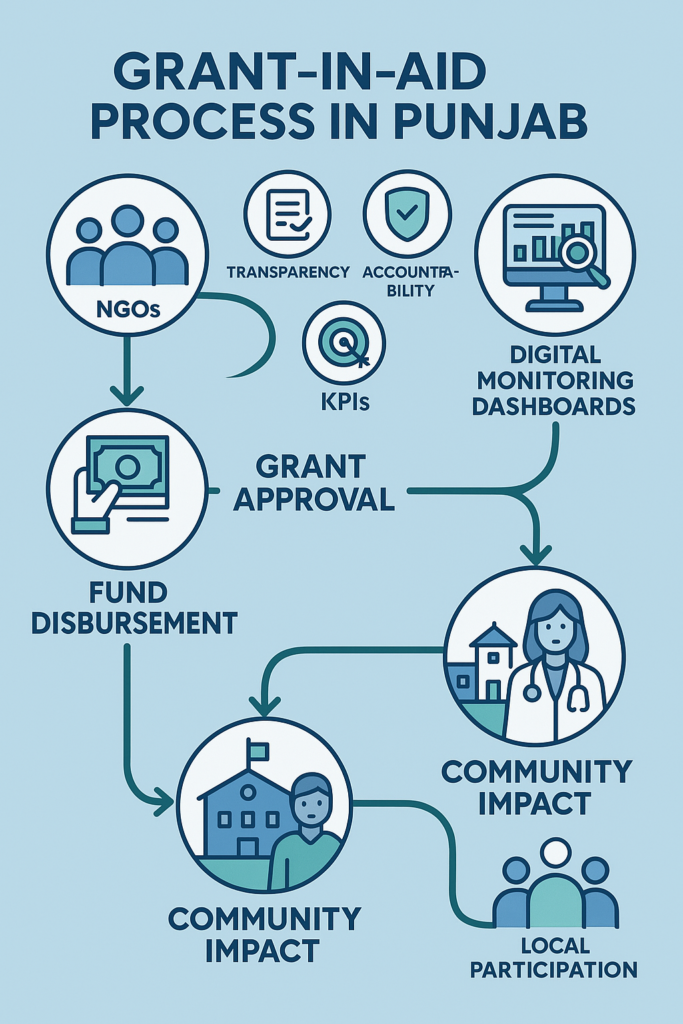
Introduction
The Government of Punjab’s Grant-in-Aid (GIA) Policy serves as a critical financial tool for supporting non-governmental organizations (NGOs), civil society actors, autonomous bodies, and local institutions engaged in public service delivery across education, health, social welfare, and cultural preservation. The policy outlines procedures, eligibility criteria, approval mechanisms, and accountability standards. This article presents an in-depth analysis of the policy, highlights its strengths and loopholes, and offers targeted recommendations to improve transparency, efficiency, and impact.
Policy Overview
The GIA policy aims to:
- Standardize the disbursement process of financial support to eligible institutions.
- Ensure public accountability and fiscal discipline.
- Promote services that align with the government’s development goals.
Under this policy, grants may be recurring (annual operational support) or non-recurring (infrastructure, equipment, one-time capacity-building support). Departments are expected to vet recipients thoroughly, ensure funds are utilized efficiently, and periodically evaluate the effectiveness of grant programs.
Strengths of the Policy
- Structured Approval Process:
- Clear vetting and review processes are defined at departmental and provincial levels.
- Applications must be accompanied by detailed financials, previous audit reports, and organizational profiles, which promotes due diligence.
- Annual Review Mechanism:
- Institutions must submit utilization certificates and audit reports to receive continued support. This check-in system encourages performance monitoring.
- Alignment with Public Interest:
- The policy explicitly favors organizations contributing to public welfare, particularly in underserved sectors like rural education and women’s health.
- Defined Eligibility Criteria:
- Eligible institutions must be non-profit, registered under relevant laws, and have a verifiable track record. This prevents ad hoc or politically driven funding allocations.
Identified Loopholes and Areas of Concern
Despite its comprehensive framework, several gaps undermine the effectiveness of the GIA policy:
1. Lack of Transparency in Allocation
While the policy demands compliance documentation, it lacks public disclosure obligations. There is no requirement for publishing annual lists of recipients, amounts granted, or outcomes achieved. This opens the door to favoritism or misuse.
2. Ambiguity Around Evaluation Metrics
There are no standard Key Performance Indicators (KPIs) or success benchmarks for grant-supported initiatives. Without measurable outputs, assessments remain subjective and may rely too much on bureaucratic discretion.
3. Weak Penalties for Non-Compliance
Although the policy mentions audits and utilization certificates, it is vague on punitive actions for misreporting, misuse, or underperformance. This limits deterrence against inefficiency or malpractice.
4. Centralization of Authority
Approval and renewal processes are highly centralized, with limited room for local government or grassroots community input. This may delay decisions and limit responsiveness to local needs.
5. Underutilization of Digital Platforms
The policy doesn’t encourage the use of digital dashboards or automated tracking of grant applications, disbursements, and utilization. Manual processes can lead to errors, delays, and inefficiencies.
Recommendations for Policy Improvement
To enhance the utility and fairness of Punjab’s Grant-in-Aid Policy, the following reforms are recommended:
1. Establish a Public Grants Dashboard
Launch an online portal where all grants are transparently listed with recipient names, project summaries, financial data, and performance reports. This would enhance public trust and civil oversight.
2. Develop Uniform Performance Indicators
Introduce sector-specific KPIs for funded organizations (e.g., number of students enrolled in schools, patients treated, awareness sessions conducted). Grant renewals should be contingent on meeting these metrics.
3. Enforce Penalties and Blacklisting
Define and implement strict consequences for fund misuse, such as blacklisting, recovery of funds, or legal proceedings. Establish a mechanism for whistleblowers to report discrepancies.
4. Decentralize and Streamline Approvals
Empower divisional and district committees to handle smaller grant applications, reducing burden on provincial secretariats and making the process more agile.
5. Digitize Application and Monitoring
Create a digital platform to handle end-to-end workflows—from application submissions to fund disbursement and progress reporting. Automation would reduce manual bottlenecks and improve efficiency.
6. Capacity Building for Grantees
Offer training programs to help NGOs and local bodies meet compliance standards, manage finances, and conduct social audits effectively.
Punjab’s Grant-in-Aid Policy is well-intentioned and provides a functional framework for supporting development partnerships with non-governmental actors. However, to maximize its impact and uphold principles of fiscal integrity, transparency, and accountability, the policy needs significant structural and procedural upgrades. By adopting digital solutions, enforcing compliance, and enhancing local participation, the Punjab government can transform the GIA mechanism into a powerful catalyst for equitable and efficient public service delivery.
